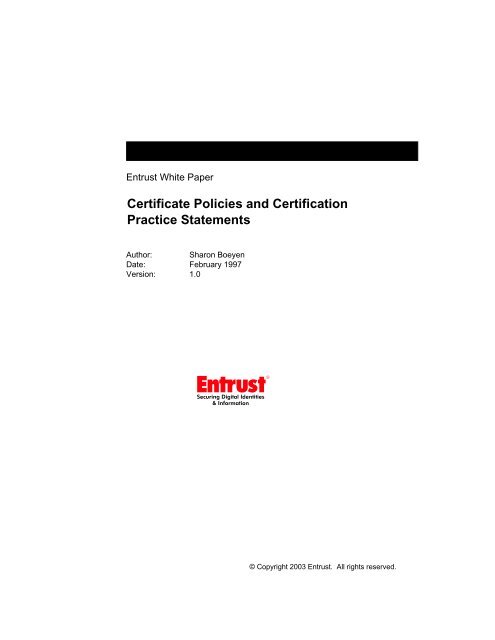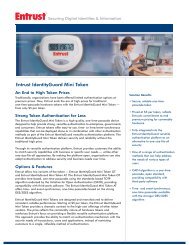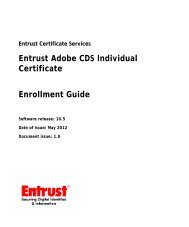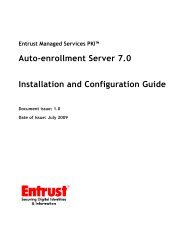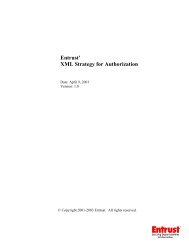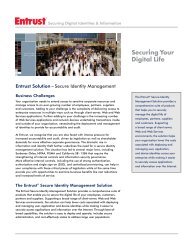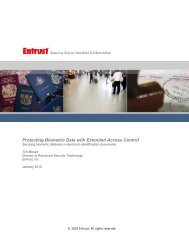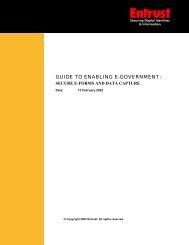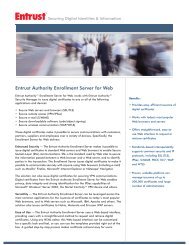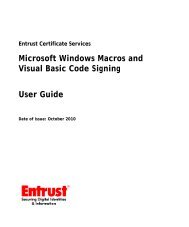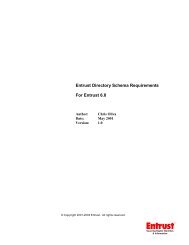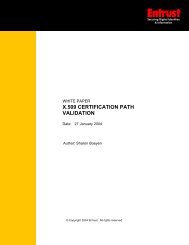Certificate Policies and Certification Practice Statements v.1.0 - Entrust
Certificate Policies and Certification Practice Statements v.1.0 - Entrust
Certificate Policies and Certification Practice Statements v.1.0 - Entrust
Create successful ePaper yourself
Turn your PDF publications into a flip-book with our unique Google optimized e-Paper software.
<strong>Entrust</strong> White Paper<br />
<strong>Certificate</strong> <strong>Policies</strong> <strong>and</strong> <strong>Certification</strong><br />
<strong>Practice</strong> <strong>Statements</strong><br />
Author: Sharon Boeyen<br />
Date: February 1997<br />
Version: 1.0<br />
© Copyright 2003 <strong>Entrust</strong>. All rights reserved.
<strong>Certificate</strong> <strong>Policies</strong> <strong>and</strong> <strong>Certification</strong> <strong>Practice</strong> <strong>Statements</strong> Page 2<br />
1. Background<br />
The automation of business processes introduces requirements for security services, such<br />
as confidentiality, integrity, authenticity <strong>and</strong> non-repudiation that can be satisfied by the<br />
<strong>Entrust</strong> TM range of products.<br />
Use of a Public Key Infrastructure (PKI) to support business processes within a single<br />
organization requires no more policy <strong>and</strong> procedures preparation than that required for<br />
any Information Technology (IT) infrastructure. Prudent businesses routinely prepare a<br />
system security policy, <strong>and</strong> the special provisions required for a PKI can be easily<br />
accommodated within such a policy. When security services involve independent<br />
organizations or security domains, they should be qualified by an explicit “quality of<br />
service”. This ensures that a user of the service does not anticipate a high quality of<br />
service or degree of assurance from a provider whose operating procedures are consistent<br />
with a lower degree of assurance. This situation could lead to what appears to the user to<br />
be a breach of security, even though the service provider has operated entirely within its<br />
own operating rules. Aspects of the system’s operation that affect the degree of assurance<br />
are commonly documented in a system security policy.<br />
Where the system includes a PKI, users need to be able to determine the degree of<br />
assurance or trust which can be placed in the authenticity <strong>and</strong> integrity of the public keys<br />
contained in certificates issued by the <strong>Certification</strong> Authority (CA). Information upon<br />
which such determinations can be made is documented in the relevant <strong>Certificate</strong> Policy<br />
<strong>and</strong> <strong>Certification</strong> <strong>Practice</strong> Statement.<br />
2. Overview<br />
A <strong>Certificate</strong> Policy, as defined in X.509, is a named set of rules that indicates the<br />
applicability of a certificate to a particular community <strong>and</strong>/or class of application with<br />
common security requirements. In any organization that operates a PKI, a Policy<br />
Authority is required to select or develop <strong>and</strong> maintain the <strong>Certificate</strong> Policy. The Policy<br />
Authority is generally the same group as that which is responsible for the organization’s<br />
IT security policy. It should include representatives from the human resources, finance,<br />
legal, audit <strong>and</strong> IT organizational units, to ensure the <strong>Certificate</strong> Policy is defined <strong>and</strong><br />
maintained in conjunction with related policies in the organization. At some time in the<br />
future, industry forums are expected to establish st<strong>and</strong>ard <strong>Certificate</strong> <strong>Policies</strong> for their<br />
respective business sectors. At such time, a Policy Authority may simply adopt or adapt a<br />
model <strong>Certificate</strong> Policy from such an association. In the meantime, the Policy Authority<br />
must develop a <strong>Certificate</strong> Policy on its own.<br />
A <strong>Certification</strong> <strong>Practice</strong> Statement (CPS) is a statement of the practices that a CA<br />
employs in managing the certificates that it issues. The Operating Authority (usually an<br />
individual within the IT unit) is responsible for preparing <strong>and</strong> maintaining the CPS. The<br />
CPS should describe how the <strong>Certificate</strong> Policy is interpreted in the context of the<br />
system architecture <strong>and</strong> operating procedures of the organization.<br />
© Copyright 2003 <strong>Entrust</strong>. All rights reserved. v1.0, February, 1997
<strong>Certificate</strong> <strong>Policies</strong> <strong>and</strong> <strong>Certification</strong> <strong>Practice</strong> <strong>Statements</strong> Page 3<br />
While a <strong>Certificate</strong> Policy is defined independently of the specific details of the operating<br />
environment of the PKI, the corresponding CPS should be tailored to the organizational<br />
structure, operating procedures, facilities <strong>and</strong> computing environment of the Operating<br />
Authority. Use of a st<strong>and</strong>ard structure for <strong>Certificate</strong> Policy <strong>and</strong> CPS documents will help<br />
ensure completeness <strong>and</strong> simplify the assessment of the corresponding degree of<br />
assurance by users <strong>and</strong> other CAs.<br />
The following example illustrates the relationship between components of a <strong>Certificate</strong><br />
Policy with the corresponding components of a CPS. The <strong>Certificate</strong> Policy generally<br />
states what is to be adhered to, while the CPS states how it is adhered to.<br />
The following <strong>Certificate</strong> Policy component<br />
“Users will inform the Operating Authority immediately upon discovery that their<br />
private key has suffered unauthorized disclosure”<br />
may be transformed by an Operating Authority into the following CPS component:<br />
· “All users (including end-users <strong>and</strong> operators of CAs) will be informed of the<br />
requirement to report unauthorized disclosure of their private key in an<br />
agreement, which they will sign prior to their being issued a certificate.<br />
· Upon discovery of the unauthorized disclosure of the private key, users will be<br />
required to contact their CA, within one working day. The method of<br />
contacting the CA will be one of those listed in the CPS.<br />
· When not in use, users will be required to keep all copies of their private key<br />
either on their person, or in a locked place.”<br />
3. Structure <strong>and</strong> Components<br />
Although a st<strong>and</strong>ard format for a <strong>Certificate</strong> Policy or CPS has not yet been finalized, a<br />
framework which includes a checklist of policy components has emerged. The items<br />
included in this checklist should be considered when establishing an organization’s<br />
<strong>Certificate</strong> Policy <strong>and</strong> CPS. These components are outlined below.<br />
3.1 Community <strong>and</strong> Applicability<br />
The CPS should identify the:<br />
· <strong>Certificate</strong> <strong>Policies</strong> with which it claims to conform;<br />
· order of magnitude of the user community that it is intended to serve, including the<br />
number of CAs <strong>and</strong> Registration Authorities (RAs);<br />
· st<strong>and</strong>ards to which its external interfaces conform;<br />
· name form used in its certificates; <strong>and</strong> the<br />
· name-space (e.g. X.500 subtree) in which the CA intends to issue certificates.
<strong>Certificate</strong> <strong>Policies</strong> <strong>and</strong> <strong>Certification</strong> <strong>Practice</strong> <strong>Statements</strong> Page 4<br />
3.2 Identification <strong>and</strong> Authentication<br />
The CPS should describe the mechanisms used to authenticate the identity of all<br />
principals, including Security Officer, Security Administrator, Directory Administrator<br />
<strong>and</strong> User. A brief statement of the privileges allocated to each role should be provided.<br />
3.3 Key Management<br />
The key management component should describe how the key life-cycles of each of the<br />
system components (including the CAs, RAs <strong>and</strong> end-users) are managed. Additional<br />
components in the area of key management include choice of:<br />
· certificate signing algorithm;<br />
· certificate validity periods; <strong>and</strong><br />
· data signing algorithm.<br />
3.4 Local Security <strong>Practice</strong>s<br />
Local security practices are those that relate to the environment in which the major<br />
components of the PKI operate including:<br />
· physical controls;<br />
· personnel controls; <strong>and</strong><br />
· procedural controls.<br />
3.5 Technical Security <strong>Practice</strong>s<br />
Technical security practices deal with the required technical st<strong>and</strong>ards for the components<br />
of the system, including:<br />
· computer security controls;<br />
· network security controls; <strong>and</strong><br />
· cryptographic module engineering controls.<br />
3.6 Operational <strong>Practice</strong>s<br />
The operational practices describe the operating procedures for the CAs, RAs <strong>and</strong> endentities,<br />
including the topics of:<br />
· registration of unique names;<br />
· de-registration/revocation;<br />
· key compromise;<br />
· dismissal for cause;<br />
· certificate update;<br />
· disaster recovery;<br />
· private key recovery;<br />
· audit practices; <strong>and</strong><br />
· non-disclosure of personal information.
<strong>Certificate</strong> <strong>Policies</strong> <strong>and</strong> <strong>Certification</strong> <strong>Practice</strong> <strong>Statements</strong> Page 5<br />
3.7 Legal Provisions<br />
The <strong>Certificate</strong> Policy may explicitly identify the statutes to which the PKI must conform,<br />
including data protection, privacy, access to information <strong>and</strong> legal wiretap legislation.<br />
The <strong>Certificate</strong> Policy should also state the purposes for which private keys are<br />
constrained to be used.<br />
Any limitation of warranty, requirements for acknowledgment of limitations by the<br />
certificate user <strong>and</strong> acceptance of obligations by the principal should be stated. Legal<br />
provisions need to be included for each of the following:<br />
· CA liability;<br />
· CA obligations;<br />
· certificate user obligations;<br />
· principal obligations;<br />
· acceptance of limitation; <strong>and</strong><br />
· informed consent.<br />
3.8 Cross-certification Agreements<br />
Independent organizations that wish to use one another’s certificates should establish a<br />
cross-certification agreement between them. This agreement should formally commit both<br />
organizations to adhere to the CPS <strong>and</strong> clarify how disputes should be arbitrated in the<br />
event that loss is incurred as a result of a failure to comply.<br />
3.9 <strong>Certificate</strong> <strong>and</strong> CRL Profile<br />
The CPS should include a profile of the certificates <strong>and</strong> CRLs <strong>and</strong> the directory schema.<br />
The profile should indicate which certificate <strong>and</strong> CRL extensions are present, whether<br />
they are marked critical or non-critical, which optional fields are included, what value<br />
ranges are allowed, <strong>and</strong> what action is expected of verifiers in response to any nonst<strong>and</strong>ard<br />
extensions. The location of these attributes in the directory should be described.<br />
3.10 CPS Administration<br />
The CPS should describe the procedures for development <strong>and</strong> maintenance of the CPS<br />
document. These should include the procedures for approving the CPS <strong>and</strong> the nature of<br />
those changes that should lead to the issuance of a new policy identifier.<br />
4. Deployment <strong>and</strong> Use<br />
X.509 version 3 format certificates include a number of extension fields, some of which<br />
are useful in conveying information about <strong>Certificate</strong> Policy <strong>and</strong> the corresponding CPS.<br />
Given that both the specification of a <strong>Certificate</strong> Policy as well as the CPS may be<br />
lengthy, it is not generally feasible to include the full description of either directly in the<br />
certificate. The description of <strong>Certificate</strong> Policy <strong>and</strong> CPS can be made available in the<br />
same repository as that used for certificates <strong>and</strong> CRLs or through other means.
<strong>Certificate</strong> <strong>Policies</strong> <strong>and</strong> <strong>Certification</strong> <strong>Practice</strong> <strong>Statements</strong> Page 6<br />
A <strong>Certificate</strong> Policy is represented in the certificate by a policy identifier in the<br />
certificate<strong>Policies</strong> extension . This identifier is in the form of a registered Object<br />
Identifier (OID) assigned by the Policy Authority responsible for its development. In<br />
future, some OIDs for <strong>Certificate</strong> <strong>Policies</strong> agreed by business sector industry forums, are<br />
expected to be registered <strong>and</strong> become widely understood, eliminating the need for users to<br />
evaluate the full policy statement .<br />
The certificate<strong>Policies</strong> extension is used to ensure that certificate users have an authentic<br />
<strong>and</strong> non-repudiable indication of the policy under which the certificate was issued, <strong>and</strong><br />
hence the applications for which it is suitable. This extension helps to prevent a verifier<br />
from using a certificate for a purpose other than that intended by the issuing CA. This<br />
also prevents a signer from repudiating a signature on the grounds that he/she did not<br />
intend the associated signature to be used for that purpose . If the PKI is to be used solely<br />
for internal corporate confidentiality <strong>and</strong> integrity/authenticity services, then this<br />
extension may be omitted from certificates issued to corporate users. Furthermore, if the<br />
<strong>Certification</strong> Authority operates a single policy, then the extension can be omitted, as the<br />
policy implied by the certificate is the declared policy of the issuer. However, even if<br />
only one policy is required today, it may be prudent to include this extension, as it will<br />
ease the transition to a multi-policy environment in the future.<br />
The certificate<strong>Policies</strong> extension also makes provision for policy qualifiers to further<br />
clarify the details of the policy identified by the policy identifier. Although st<strong>and</strong>ard<br />
syntax for these qualifiers is not yet set, the intention is that they will either contain a<br />
terse text description of the policy, or a pointer to the location of the full text of the<br />
<strong>Certificate</strong> Policy <strong>and</strong>/or CPS. If pointers use the GeneralizedName syntax defined in<br />
X.509, retrieval of these documents from a Web page or X.500 Directory system would<br />
be quite straightforward. The CPS can be presented as a single document, or it can be<br />
presented as a set of documents with one being a brief, user-friendly summary for endusers.<br />
When trust relationships are established between CAs, the <strong>Certificate</strong> <strong>Policies</strong> supported<br />
by each may not be identical. In support of cross-certification, the X.509 version 3<br />
certificate format includes an extension field policyMappings for CA certificates. This<br />
field is used to indicate that a particular policy supported by one of the CAs is considered<br />
equivalent by the other CA to a policy that it supports. The OIDs of the two policies are<br />
included in the extension field.<br />
5. Summary<br />
<strong>Certificate</strong> <strong>Policies</strong> <strong>and</strong> <strong>Certification</strong> <strong>Practice</strong> <strong>Statements</strong> are key components in<br />
establishing the degree of assurance or trust that can be placed in certificates issued by<br />
CAs. In a restricted, single security domain environment, formalizing these policies <strong>and</strong><br />
practices may not be required. However, if future plans are to exp<strong>and</strong> beyond this<br />
restricted scope, more formal policy <strong>and</strong> procedure definition is required, through the use<br />
of <strong>Certificate</strong> Policy <strong>and</strong> CPS documents. This will help ensure that policies <strong>and</strong> practices<br />
can be easily interpreted <strong>and</strong> assessed by the users <strong>and</strong> administrators who need to<br />
determine the degree of assurance in certificates issued by a <strong>Certification</strong> Authority. The
<strong>Certificate</strong> <strong>Policies</strong> <strong>and</strong> <strong>Certification</strong> <strong>Practice</strong> <strong>Statements</strong> Page 7<br />
planning, development <strong>and</strong> maintenance of a <strong>Certificate</strong> Policy as well as a CPS should<br />
be conducted in close cooperation with, <strong>and</strong> with input from, many organizational units to<br />
ensure consistency throughout the organization. Establishing this framework within an<br />
organization at the early stages of setting up a PKI will help simplify the task <strong>and</strong> ease its<br />
integration with the related business processes of the organization.<br />
<strong>Entrust</strong> is a registered trademark of <strong>Entrust</strong>, Inc. in the United States <strong>and</strong> certain other<br />
countries. <strong>Entrust</strong> is a registered trademark of <strong>Entrust</strong> Limited in Canada. All other <strong>Entrust</strong><br />
product names <strong>and</strong> service names are trademarks or registered trademarks of <strong>Entrust</strong>, Inc or<br />
<strong>Entrust</strong> Limited. All other company <strong>and</strong> product names are trademarks or registered<br />
trademarks of their respective owners.<br />
© Copyright 2003 <strong>Entrust</strong>. All rights reserved.


